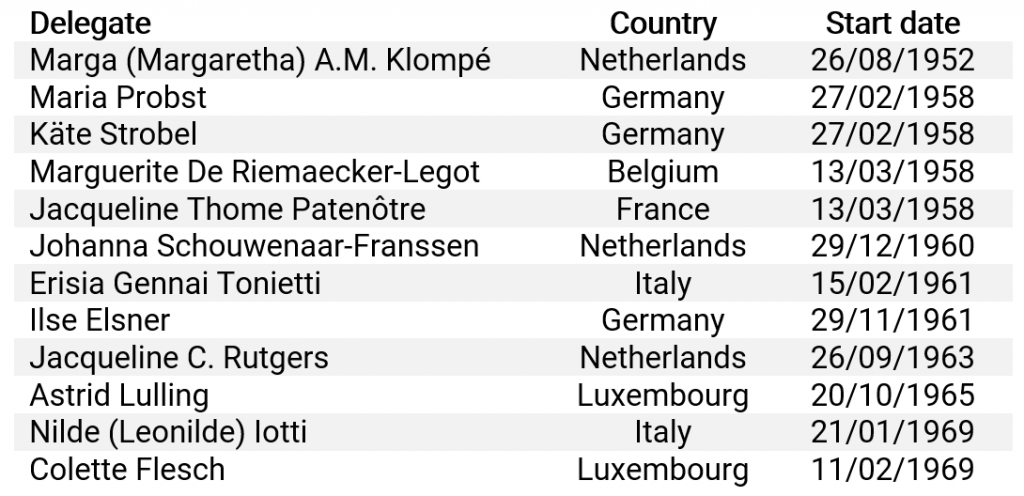By Simona Guerra
Women are largely absent from accounts of the early European integration process. Yet as Simona Guerra explains, there were a number of women who played an important role in setting the trajectory of the integration project during this period. Drawing on new research, she outlines the contributions made by the first twelve women appointed as representatives in the Common Assembly and the European Parliament in the 1950s and 1960s.
Whenever we open a textbook on the European Union, we can read accounts of the founding fathers of the integration project and the politicians who shaped European integration in the 1950s and 1960s. Yet within these accounts, women are almost entirely absent.
Although it is true that there were not many women in important positions of power during this time, some were appointed as representatives in the Common Assembly, the forerunner to the European Parliament. Some of these women made significant contributions to the integration project, as did others who held roles at the international, European, and national levels.
As Gabriele Abels and Heather MacRae write, the downplaying of women in accounts of European integration means that our history of the process remains incomplete. For this reason, recent work has focused on shining a light on the role played by women. Maria Pia Di Nonno has worked on a project covering the biographies of women who have shaped European integration, while feminist international relations scholars have addressed the marginalisation of women’s voices in EU studies.
Drawing on this work, I have undertaken a project to present the profile and work of the early women of European integration. I argue that a greater number of studies and chapters by EU scholars should be dedicated to the impact these women had in the early years as makers and shapers of the integration process.
The original Common Assembly, which existed from 1952 to 1958, had only 78 members from the original six member states (Belgium, France, Germany, Italy, Luxembourg, and the Netherlands). However, five women joined the Assembly in the 1950s and a further seven joined the European Parliament in the 1960s. They have been described as female pioneers and they sat with the so-called founding fathers of European integration.
Table: List of women delegates to the Common Assembly and European Parliament in the 1950s and 1960s
Source: EPRS Historical Archives data
Of course, as the parliament was different and smaller compared to the institution we know today, there were fewer committees, but these women were members of the committees that did exist. They were appointed as rapporteurs, and they actively took part in the politics of the time.
Marga Klompé, from the Netherlands, appears in quite a few documents and committees of the Common Assembly. Klompé was the first woman appointed, in August 1952, and she was active in the works of the Committee on the Political Affairs and External Relations of the Community and the Sub-Committee on Commercial Policy, where she was appointed as rapporteur on eight reports related to the activities of the Community (1952-1953) and its external relations. The debates in this committee examined the practical achievements of Europe and the Community.
In Klompé’s words, ‘the Community is an economic entity which currently covers the territory of a number of well-defined countries, but it cannot apply a new isolationist policy since it hopes to work towards a stronger united Europe, aware of its common heritage, which alone can become a powerful partner in Atlantic cooperation.’ Far from a possible dichotomy between ‘Little Europe’ and ‘Greater Europe’, Klompé positively addressed the policy of détente after the death of Stalin, but warned against the possible Soviet strategic objective of creating discontent across Europe at the expense of European unification.
Europe has an enormous task to accomplish in the world and has to ensure that it continues to be a powerful and effective partner in Atlantic cooperation. More than ever, the political situation means that we must be firm, realistic and idealistic. – Marga Klompé, 1953
Jacqueline Thome-Patenôtre, from France, was received in October 1956 by the American President Dwight D. Eisenhower. On her return, she wrote that ‘more than ever, by studying the geographical, economic and demographic structure of the USA, we realise that only a unified Europe can save the European nations from decadence’.
Ilse Elsner from Germany was appointed in November 1961. She was a politician, a journalist, and a diplomat who actively worked on the European Social Funds, and later, as Chairwoman of the Economic and Financial Committee up to 1970. She was the rapporteur of numerous Reports of the Social Committee related to the European Social Funds and their effectiveness.
Mechthild Roos references one of her plenary speeches in December 1969. Writing about the European Social Fund (ESF), Roos details the way MEPs behaved in what was a fully-fledged supranational parliament. The Committee on Social Affairs worked on the ESF’s social and policy dimension, while the Committee on Budgets mainly worked on safeguarding and extending the European Parliament’s budgetary powers.
These are just some examples of how the first twelve women in the Common Assembly and European Parliament actively shaped the early years of European integration through their domestic, European, and international actions. Given these contributions, it is reasonable to suggest that future accounts of the early integration process should do more to improve our familiarity with these women’s names and work.


